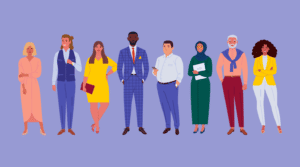By Sanjay Khatnani, Managing Partner, J2 Solutions
Over the past few years, the business community has seen a cultural shift, as pay equity, gender parity, rooting out bias and discrimination continue to gain momentum. Today, creating a diverse, inclusive workplace is not a nice-to-have—it’s essential. The fact is, a more diverse workforce breeds better creativity, more harmonious working environments, and, ultimately, a better understanding of each other and the customer.
nice-to-have—it’s essential. The fact is, a more diverse workforce breeds better creativity, more harmonious working environments, and, ultimately, a better understanding of each other and the customer.
The COVID-19 pandemic, though disruptive and unsettling, set the foundation for significant advancements for diversity in the workplace. When the world went remote, businesses were forced to rewrite their hiring and management playbook. Many lessons were learned along the way as a foundation for a more inclusive work environment was established.
Here are three ways the COVID-forced remote workforce helped shape diversity and inclusion in the workplace:
More opportunity for individuals with disabilities: The virtual workplace has proven tremendously beneficial for those with physical disabilities who are no longer hindered by an employer’s lack of accommodations. In a remote environment, disabled employees are set up according to their specific needs in their own space, thus supporting productivity and job success.
The remote workplace has also helped to remove negative perceptions of the disabled employee who may need to take longer work breaks or work with a personal care assistant during the workday. Let’s face it, we’ve all had to adjust our work schedules to accommodate some aspects of our personal lives. No one thinks anything of a colleague or employee who has to log off for an hour to help the kids with Zoom or take the dog for a walk. The same now goes for individuals with disabilities.
Equal playing field for working moms: Previously, requesting telework arrangements to accommodate family needs was viewed as a luxury and, in some organizations, even discouraged. The work-from-home mom (sometimes dad, but historically mom) was frequently perceived as less committed to her career, perpetuating gender bias. Today, the playing field is level. We’ve all been forced to work from home, and any bias that once existed towards the work-from-home mom is now gone—or at least diminished. Many people who once frowned upon the notion of working remotely—men and women alike—have changed their opinion on the matter, seeing first-hand the resulting work-life benefits in their own lives.
A better understanding of who we are as people: Meetings that were once held in person, set against a backdrop of whiteboards and florescent lighting, now offer a glimmer into a person’s life, as video conferencing takes us into the personal spaces of our colleagues. In today’s typical meeting held over video conferencing, we might see a child’s artwork or unique décor in the background. Your meeting might even feature the appearance of a family pet, a child or possibly a spouse walking by.
Though letting others into our personal living space may have been unsettling at first (that’s just not what you do with colleagues and your boss, right?), it actually lets us see our fellow coworkers as more than all-business. Today, we see each other as real people who have a life, interests and loved ones outside of work. It humanizes us. Before, our coworkers saw one side of us. Now, we’re all getting more insight into who we are as people—our differences and similarities—which creates stronger bonds and greater team chemistry.
The last year of the remote workforce has, in many ways, been a great equalizer. The traditional workplace has been redefined, bringing with it a tremendous opportunity for companies to recruit talent across various segments in our society. There has never been a better time for organizations to up their inclusion game.
